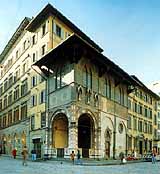
The Loggia of the Bigallo
Excusez nous mais cette page n'est pas été encore traduite en Français
The Loggia "of the Bigallo", standing on the corner between Piazza
San Giovanni and Via Calzaiuoli, forms part of a mediaeval building
that was originally the headquarters of the Archconfraternity
of the Misericordia; it was built between 1352-58 by Alberto Arnoldi,
sculptor and architect who also worked on the building site of the Duomo and
carried out several of the bas-reliefs on the Belltower.
This loggia was originally used to show abandoned children to the public,
one of the Company of the Bigallo's principle tasks of charity. Its well-documented
name derives from the Compagnia Maggiore of Santa Maria del Bigallo which
ran the Hospice for pilgrims and travellers of Santa Maria a Fonteviva,
known as the Bigallo.
According to another tradition, the present loggia and oratory were built thanks
to a donation given to the Company by a private benefactor who owned a house
on the corner of Corso Adimari (today Via Calzaiuoli). The two wide arches are
decorated with bas-reliefs of Prophets, Angels, the Virtues and Christ in benediction.
They were bricked up in 1697 to enlarge the oratory and not restored to their
original aspect until 1889. The first floor boasts three-foil windows while three
tabernacles by Filippo di Cristofano (1412) with statues of the Madonna and Child,
St. Lucy and St. Peter the Martyr, founder of the Archconfraternity
of the Misericordia, decorate the facade.
The painted statues by Ambrogio di Baldese (1350 circa), were brought here when
the two Companies were unified in 1425 (this only lasted until 1490). Today some
of the rooms of the palace and oratory are used for a Museum containing
works of art from the collection of the Company of the Bigallo, which were lost
for a time, until they were put together again in 1904.
